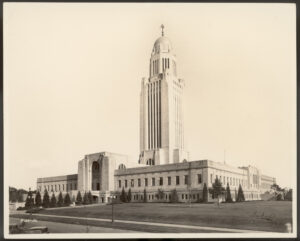Discover History Nebraska’s most popular images. Search images from our Native American collections, the Macdonald Studio Collection (Lincoln, NE), and historical events from all over Nebraska. We are working hard to build this new database and adding new images often.
Suggested Searches:
Prairie Settlement
Search approximately 3,000 glass plate negatives crafted by famous Nebraska photographer Solomon D. Butcher to record the process of settlement in Nebraska between 1886 and 1912. Butcher photographed actively in central Nebraska including Custer, Buffalo, Dawson and Cherry counties. This database also features approximately 3,000 pages of Oblinger family letters discuss land, work, neighbors, crops, religious meetings, problems with grasshoppers, financial problems, and the Easter Blizzard of 1873. The database was created through a partnership with the Library of Congress’ American Memory Project.
Suggested searches:
Nebraska Memories
Nebraska Memories is a cooperative project to digitize Nebraska-related historical and cultural heritage materials and make them available to researchers of all ages via the Internet. Nebraska Memories is brought to you by the Nebraska Library Commission. History Nebraska contributed nearly 800 images from two amazing and vastly different collections, the John Nelson Collection and the John Anderson Collection. To look at History Nebraska’s photographs, click on “Search” and add History Nebraska to the selected collections column.
John Nelson was born in Harestad, Sweden, in 1864. He came to Nebraska with his parents at the age of seventeen. His photographs tell the story of small-town life in Nebraska during the first decades of the twentieth century. His subjects included local businesses, community activities, and early automobiles.
Suggested searches:
John Anderson was a photographer who worked primarily at Fort Niobrara in Nebraska and on the Rosebud Reservation in South Dakota. Born in Sweden in 1869, he came to this country with his parents, eventually settling in Cherry County, Nebraska, in 1884. There are more than 350 glass plate negatives in the collection, including formal portraits of Fool Bull, Ben Reifel, and Crow Dog. Also included are scenes from around Rosebud and views of Fort Niobrara.
Suggested searches:
In an effort to make Omaha artifacts and photographic images more available, this project is creating an online catalog of tribal resources drawn from international sources. Partners in the project are the University of Nebraska State Museum, which houses some important Omaha artifacts; the University of Nebraska-Lincoln Libraries, and History Nebraska. The University Libraries has significant experience in cataloging images and creating web-accessible databases. There are Omaha artifacts in the Nebraska History Museum, Omaha photographic images in the Library and Archives and a state-of-the-art digitization lab. These partners are working together with consultants from the Omaha tribe to create this website that was partially funded by a grant from the Institute of Museum and Library Services.
This website is not searchable. Click on the Photograph link and enjoy a decade-by-decade virtual exhibit of a selection of photographs featuring the Omaha Tribe.
The Plains Indian Ledger Art Project (PILA) facilities the digitization of the unique genre of Plains drawing on paper created during the 1860-1900 period, in order to promote preservation, research, and public access. The project is located in the Department of Ethnic Studies at UC San Diego. PILA is offered world-wide, without charge, as an educational resource for all. NSHS shared digital copies the Keeling Ledger Book (11310-55) and the Soldier’s Diary Ledger.




